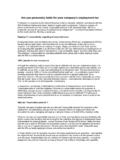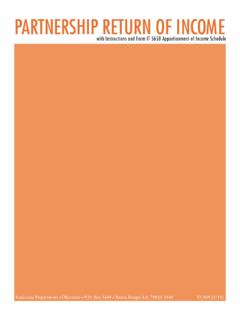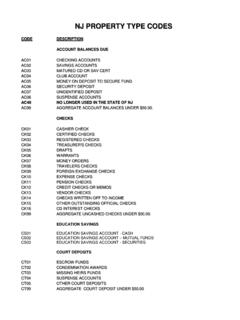Transcription of Personal holding company unsuspecting tax traps - Cho Chan
1 Personal holding company unsuspecting tax traps The closely-held corporate form of entity is widely used by family-owned businesses. As its name implies, the owners of the business are typically limited to a small group of shareholders. Many businesses operate for years as closely-held corporations without giving a second thought to a little-known danger: the Personal holding company tax. The Personal holding company tax lurks in the background to prevent the use of closely-held family corporations as reservoirs in which to collect investment income . The government wants corporations to distribute income rather than enabling shareholders to build an investment portfolio subject only to the corporate income tax. The tax is triggered by a corporation's percentage of investment to total income . It is imposed on undistributed earnings and is added to the regular corporate tax. One frequent trigger for the Personal holding company tax is the accumulation of income earmarked for expanding the business.
2 Despite its ominous nature, the tax can be anticipated and maybe even averted through strategic planning. Some triggers Here are some scenarios that have unfortunately triggered the Personal holding company tax for other businesses: A consolidated return group becomes unaffiliated, or an ineligible group, as the result of a change in stock ownership or a line of business A large amount of insurance proceeds are invested until replacement property can be purchased For asset protection purposes, a corporation holds investment assets or operating equipment without engaging in other operations During a plan of liquidation, a line of business is sold and the sale proceeds are invested while management is attempting to sell remaining assets or businesses As part of a plan to invest in a new line of business, a line of business is sold and the sale proceeds are invested while management is attempting to acquire a business or grow its new line of business Two tests It's important to remember that any corporation can be a Personal holding company .
3 The IRS has developed two tests: (1) an income test and (2) an ownership test. income test The income test is met if 60 percent or more of the corporation's adjusted ordinary gross income is " Personal holding company income ." This type of income is frequently derived from investment properties and includes: Interest, dividends and royalties Rents Mineral, oil and gas royalties Copyright royalties Produced film rents Amounts received in compensation for use of the corporation's property Compensation from Personal contracts, where the corporation is not a Personal service company Estate and trust income There are some important exceptions to this list. Some types of royalties, for example, are excluded. Note: The PHC income test is not a test of gross receipts. The income test compares gross receipts less the cost of goods sold to investment income less its direct costs. Gross profit margins are significant to the test and investment activities generally have few direct costs.
4 Thus, an increase in investment income is leveraged for purposes of the PHC income test and an increase in investment income that is insignificant to total gross income can cause investment income to exceed 60 percent of adjusted gross income (AGI). Manufacturing businesses are at a disadvantage. Because of high cost of goods sold when compared to a service business that has little or no costs of goods sold. Ownership test The ownership test is met if five or fewer individuals owned more than 50 percent of the corporation's stock value at any time during the last half of the tax year. The ownership test also has some important exceptions. Some important - and common - types of corporations are excluded: S corporations Tax-exempt corporations Banks, lending or finance companies Small business investment companies Corporations in bankruptcy The Personal holding company tax doesn't have to be an unwelcome and expensive surprise.
5 If your business has experienced - or is planning - any of the events that could trigger the tax, give our office a call. Careful planning can help avoid or minimize the tax; at any rate, it can alert you to your possible liability for the tax.









